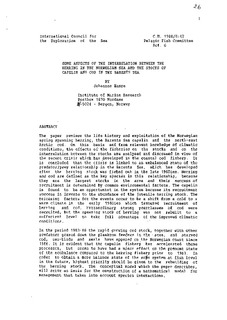| dc.description.abstract | The paper reviews the life history and exploitation of the Norwegian spring spawning herring, the Barents Sea capelin and the north-east Arctic cod. On this basis and from relevent knowledge of climatic conditions, the effects of the fisheries on the stocks and on the
interrelation between the stocks are analysed and discussed in view of the recent crisis which has developed in the coastal cod fishery. It is concluded that the crisis is linked to an unbalanced state of the predator/prey relationship in the Barents Sea, which has developed
after the herring stock was fished out in the late 1960ies. Herring and cod are defined as the key m e s in this relationship, because they are the largest stocks in the area and their success of recruitment is determined by common environmental factors. The capelin is found to be an opportunist in the system because its recruitment
success is inverse to the abundance of the juvenile herring stock. The releasing factors for the events occur to be a shift from a cold to a warm climate in the early 1980ies which favoured recruitment of
herring and cod. Extraordinary strong yearclasses of cod were recruited, but the spawning stock of herring was not rebuilt to a sufficient level to take full advantage of the improved climatic
conditions.
In the period 1983-86 the rapid growing cod stock, together with other predators grazed down the plankton feeders in the area, and starved cod, sea-birds and seals have appared on the ~orwegian coast since 1986. It is evident that the capelin fishery has accelerated these
processes, but seems to have had a minor effect on the present state of the ecobalance compared to the herring fishery prior to 1983. In order to obtain a more balance state of the ec$o system at fish level in the future, highest priority should be given to the rebuilding of
the herring stock. The conceptual model which the paper describes, will serve as basis for the construction of a mathematical model for management that takes into account species interactions. | en_US |
